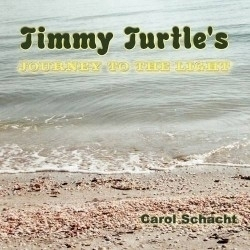Timmy Turtle's Journey to the Light
The struggle for loggerhead turtles to survive in Gulf waters and successfully nest on Florida beaches is of environmental concern to many. Author Carol Schacht attempts to heighten awareness of turtle issues with the anthropomorphized characters in her chapter book for young readers.
The story begins with Tillie the turtle swimming ashore to lay her dozens of golf ball-size eggs. She must get back to the sea, so she entrusts Arthur the alligator, who lives under a boardwalk, to keep her eggs safe for the next fifty-four or so days.
Arthur enlists the help of other Florida creatures, from a willet (a type of sandpiper), to small lizards called anoles and skinks. Most of the hatchlings head from the nest for the sea, but one, Timmy, becomes confused and starts walking to town instead. A meeting of other critters, including an iguana, a butterfly, a dragonfly and a Kingsnake, produces a plan to save Timmy.
Schacht’s mix of fact and the improbable is confusing. She includes good information about life-threatening problems for loggerheads, such as onshore bright lights that distract hatchlings from crawling to the sea, but she mentions a loggerhead’s “painted tail” and Tillie’s “weight of about six hundred pounds.” Most authorities agree that the average adult loggerhead weighs 250-300 pounds, and they do not note a “painted tail.” And although the author may have seen an alligator by the beach, they are typically found only in freshwater, not saltwater environs. Arthur’s beachside presence is misleading for children learning about the environment.
The illustrations are amateurish at best, but do give a sense of what a dragonfly, for example, looks like. Better editing would have caught major punctuation and hyphenation errors: periods are found outside quotation marks, and numbers, such as eighty-one and eighty-two, both need standard hyphens. Books for young learners need to be correct.
There are moments of humor that may tickle readers. When Tillie asks Arthur to guard the nest, for example, he replies, “It is not often that I’m asked to watch over someone’s offspring, for as you know, I’m not a vegetarian.” Then he says, “smiling with his crocodile smile,” that he will gladly help. Crocodiles and alligators, however, have quite differently shaped jaws, and this adds to the confusion with facts.
Nevertheless, the book is well-meaning and may help readers of all ages understand why they need to turn out their beach-area lights during turtle hatching season.
Disclosure: This article is not an endorsement, but a review. The publisher of this book provided free copies of the book and paid a small fee to have their book reviewed by a professional reviewer. Foreword Reviews and Clarion Reviews make no guarantee that the publisher will receive a positive review. Foreword Magazine, Inc. is disclosing this in accordance with the Federal Trade Commission’s 16 CFR, Part 255.

